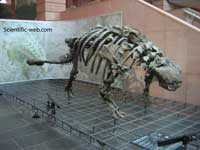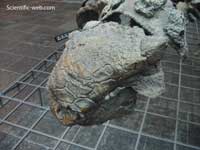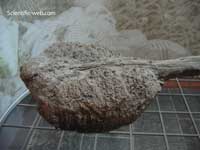


Euoplocephalus tutus, Euoplocephalus tutus, Euoplocephalus tutus,
| Euoplocephalus Fossil range: Late Cretaceous |
||||||||||||||||||
|---|---|---|---|---|---|---|---|---|---|---|---|---|---|---|---|---|---|---|
| Scientific classification | ||||||||||||||||||
|
||||||||||||||||||
| Species | ||||||||||||||||||
|
Euoplocephalus (pronounced /juːˌɒploʊˈsɛfələs/ yu-OP-lo-SEF-ah-lus) meaning 'well-armored head' (Greek eu-/ευ- meaning 'well', hoplo-/οπλο- meaning 'armed' and kephale/κεφαλη meaning 'head') was one of the largest genera of ankylosaurian dinosaurs, at about the size of a small elephant. It is also the ankylosaurian with the best fossil record, so its extensive spiked armor, low-slung body, and great club-like tail are well documented. Genera that are thought to be the same as Euoplocephalus include Scolosaurus, Anodontosaurus, and Dyoplosaurus.
Description
Among the ankylosaurids, Euoplocephalus was exceeded in size only by Tarchia and Ankylosaurus. Euoplocephalus was 6 meters (20 ft) long and weighed about 2 metric tonnes (2.2 tons). While it was 2.4 meters (8 ft) wide, it was low-slung, with short, stout legs. The rear legs were larger than the front legs and all four limbs were tipped with hoof-like claws.
Like all ankylosaurids, it had a flat, thick, triangular skull. The mouth included a horny beak and the teeth were small and roughly leaf-shaped. It had a short neck.
Armor
The entire head and body of the Euoplocephalus are covered with bands of armor, which allowed a surprising amount of flexibility. It was the first ankylosaurid discovered with armored shutters that it could slide down to cover its eyelids.
Each piece of armor was composed of a thick oval plate, embedded in the thick surrounding skin, which was studded with short, horny spikes (dermal scutes, like those of crocodiles), which were about 10 to 15 centimeters (4 to 6 inches) long. In addition to the spines running down its back, Euoplocephalus had large horns growing from the back of its head.
It also had a bony club at the end of its rigid tail, which it carried above the ground. The tail was muscular, so the club could be swung from side to side for defense.
Internally, many bones were fused together to provide support for the heavy armor. The backbone (the dorsal vertebrae) is merged with the ribs, and several of the backbones in front of the hips (presacral vertebrae) were also fused together into a rod. The tail is made from hardened tissues, which are fused to the tail bones (known as caudal vertebrae).
Paleobiology
Euoplocephalus lived between 85 and 65 million years ago, in the Campanian- Maastrichtian age of the late Cretaceous period.
Euoplocephalus was a plant eating (herbivorous) dinosaur. It had a complicated nose design (nasal structure), which indicates that it probably had a good sense of smell. It had flexible legs, which it might have used for digging. The stiff, low-slung dinosaur had poor teeth (weak dentition), so it probably would have grazed on fleshy low-lying vegetation and shallow tubers.
As all the skeletons discovered have been isolated, the conventional wisdom is that all ankylosaurids were solitary. However the discovery of a herd of 22 young Pinacosaurus was announced in 1988, which indicates that Euoplocephalus may have displayed herd behavior, at least as a juvenile.
The underbelly of Euoplocephalus was not as heavily armored as its back. Like a porcupine, flipping it over may have been the only way to harm it. A survey of dinosaur bones in Alberta, Canada supports this, showing many bite marks on dinosaurs like the unarmored Hadrosaurus, but none on the ankylosaurids.
Classification and material
Paleontologist Lawrence Morris Lambe discovered the first specimen (the holotype) 1902 and proposed the name Stereocephalus. However, the name was already preoccupied (the name had already been given to an insect), so he changed it to Euoplocephalus in 1910. This new name has been misspelled in more than a dozen different ways, in formal scientific literature. It was also once thought to be the same genus as Ankylosaurus.
Fossils from more than 40 individuals have been discovered in Alberta, Canada and Montana in the United States, making Euoplocephalus the best known ankylosaurid. This includes 15 skulls, teeth, and a few almost-complete skeletons, found with the armor still attached. Individual armor plates are the most commonly found element from them.
Cladogram
A simplified version of one possible evolutionary tree (a cladogram):
- Ornithischia ("bird hipped" dinosaurs)
- Thyreophora (the armored "shield bearers")
- Ankylosauria (the "fused lizards")
- Nodosauridae (ankylosaurs with large spikes and no tail club)
- Ankylosauridae (ankylosaurs with a tail club)
- ?Polacanthinae (like Gastonia)
- Ankylosaurinae (like Ankylosaurus and Tarchia)
- Euoplocephalus
- Ankylosauria (the "fused lizards")
- Thyreophora (the armored "shield bearers")
External links
* Euoplocephalus from the Dino Directory of the Natural History Museum, in London. (illustrations)
Retrieved from "http://en.wikipedia.org/"
All text is available under the terms of the GNU Free Documentation License

